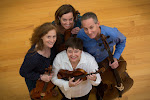Hello. This is Ana, the most technologically and cyberspacially challenged member of the Serafin Quartet. I guess that would explain my entry being the very last.
Since my colleagues have shared the macroscopic aspects of string quartets, I would like to dwell upon the individual perception of being in a string quartet. Our violinist, Tim, had touched upon the subject with some interesting points that are endemic to all fine chamber groups including adjustment to the style of playing. Due to historically established practice of assigning more or less harmonic material to the viola part in chamber and orchestral scores, adjusting stylistically to other instrumentalists within the group is something that is more or less intuitive to a violist. What will a violist do to please and appease the complex canvass of an unveiling sonic terrain dominated by the violins and a cello? Just about anything! The docile nature of a viola part is the leading cause of agoraphobia among the violists :-)
With jokes aside, I must say that the repertoire we choose has plenty of leading viola material. Equal thematic distribution within a chamber group is bound to pose few obstacles, most of which including the stylistic preferences or vignetting of phrases could be resolve with some (or a lot) of work. Yet, there is a one very crucial aspect that, if being overlooked, could have a significant negative impact on a performance. It is known as the group timbre.
Timbre of stringed instruments of the violin family, which includes violins, violas and cellos, is determined by many factors such as type and age of wood, correlation of the thicknesses of the top and back plates that culminate in an acoustic "aftertaste" characteristic of all string instruments. Needless to say that achieving a conformity in timbre that is so need during transitional passages in music is nearly impossible. However, with the right tools a string quartet can create a perfect symmetry in sound.
As a member of the Serafin Quartet, I am very fortunate to play on a fine mid-18th century viola made by Carlo Antonio Testore in Milan, Italy and loaned to the quartet by Dr. William J. Stegeman. The viola is a perfect match to a violin played by Tim also made by the same maker as well as the Testore school cello played by Larry. It is worth noting that Kate's instrument, created by the highly regarded Venitian maker Santo Serafin during earlier period is a perfect compliment to the overall sonority of the group. When put together, the instruments create a true surround sound effect, indulging the listener with the most glorifying overtones.
Now that I've shared with you one of our biggest secrets, I guess there is no more excuse for us to be anything but the best!
Subscribe to:
Post Comments (Atom)


No comments:
Post a Comment